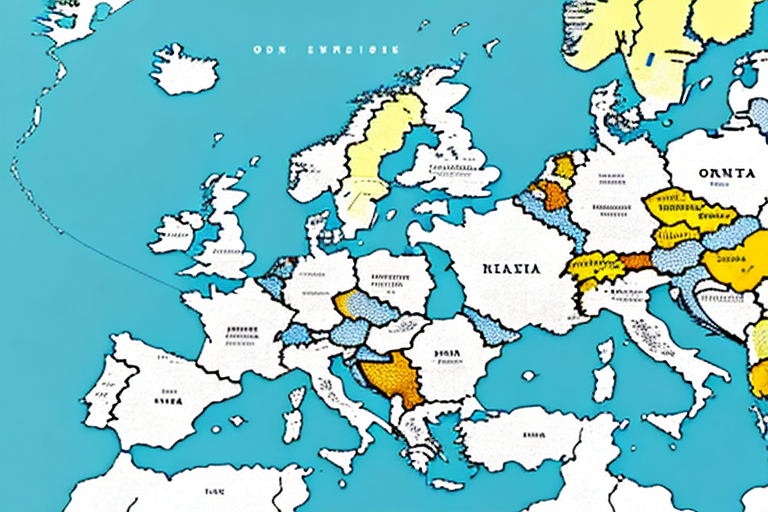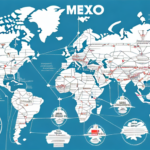Understanding UPS Shipping Rates to Europe
If you're looking to ship goods from the United States to Europe, it's crucial to understand the shipping rates and policies of your chosen carrier. In this article, we'll take a detailed look at UPS and their international shipping rates to Europe. You'll learn how rates are determined, what factors can affect them, and how to calculate an estimate of your shipping costs.
How UPS Determines Shipping Rates to Europe
UPS utilizes several factors to determine shipping rates to Europe. The most significant factor is the weight of the shipment; heavier packages incur higher shipping costs. Additionally, UPS considers the size and dimensions of the package, as well as the origin and destination countries. Accurate measurement is essential to avoid unexpected charges.
Service level selection is another critical determinant of shipping rates. UPS offers a range of express shipping services, including UPS Worldwide Express, UPS Worldwide Express Plus, and UPS Worldwide Saver. These services provide faster delivery times but come with higher costs. Businesses should assess their delivery speed requirements to choose the most cost-effective option.
The type of goods being shipped also affects shipping rates. Items such as hazardous materials or perishable goods may require special handling or transportation, increasing the overall cost. Proper classification and accurate information provision to UPS are essential to ensure correct billing and compliance with international regulations.
Factors That Affect UPS Shipping Rates to Europe
Beyond weight and service level, several other factors influence UPS shipping rates to Europe:
- Shipping Destination: Different European countries have varying shipping rates based on distance and regional logistics.
- Customs Requirements: Each country has specific customs regulations that can impact shipping costs, including duties and taxes.
- Time of Year: Peak seasons, such as holidays, can lead to increased rates due to higher demand.
- Additional Services: Services like signature confirmation, insurance, and customs clearance assistance add to the overall cost.
- Package Size and Dimensions: Oversized or irregularly shaped packages may incur additional fees.
- Type of Goods: Certain items require special handling, leading to higher shipping costs.
Understanding these factors can help you better anticipate shipping costs and make informed decisions when planning international shipments.
An Overview of UPS Shipping Zones in Europe
UPS categorizes Europe into different shipping zones based on the distance between the origin and destination countries. Proximity between countries generally results in lower shipping rates. Additionally, the type of package—whether it's an envelope, box, or bulky item—affects the rate.
Within each zone, UPS offers various shipping options, such as standard or express delivery. Customers can select the option that best aligns with their needs and budget. Furthermore, UPS provides comprehensive tracking information for all shipments, enabling customers to monitor their packages in real-time.
Additional services offered by UPS, including insurance and customs clearance assistance, are particularly beneficial for businesses that regularly ship internationally and need to navigate complex customs regulations effectively.
The Differences Between UPS Standard and UPS Worldwide Express Shipping to Europe
Choosing between UPS Standard and UPS Worldwide Express depends on your specific shipping needs:
- UPS Standard: This is a more affordable option for shipping to Europe but comes with longer delivery times. It's suitable for non-urgent shipments where cost savings are a priority.
- UPS Worldwide Express: Offers faster delivery times and more comprehensive tracking services at a higher price point. Ideal for urgent shipments requiring timely delivery and detailed tracking.
Assessing the urgency and importance of your shipment will help you decide which service level is most appropriate for your needs.
How to Calculate Your Estimated UPS Shipping Costs to Europe
Calculating your estimated UPS shipping costs to Europe is straightforward with the UPS Shipping Calculator. To obtain an estimate, you'll need to input the origin and destination countries, the weight and dimensions of your shipment, and your desired service level. The calculator will then provide a detailed breakdown of your estimated shipping costs.
Keep in mind that the estimated costs are just that—estimates. Actual shipping costs may vary due to factors such as fuel surcharges, customs fees, and additional services selected. It's advisable to verify your estimated costs with a UPS representative before finalizing your shipment to ensure accuracy.
Strategies for Reducing Your UPS Shipping Costs to Europe
Reducing UPS shipping costs to Europe can be achieved through several strategies:
- Select Slower Service Levels: Opting for services like UPS Standard instead of express options can lead to significant savings.
- Consolidate Shipments: Combining multiple shipments into one larger shipment can reduce overall shipping costs.
- Negotiate Rates: Frequent shippers may negotiate lower rates directly with UPS or through third-party logistics providers who can secure better deals on your behalf.
- Use Alternative Shipping Methods: Consider sea or rail freight for large or non-urgent shipments, as these methods are often more cost-effective than air freight.
Implementing these strategies can help optimize your shipping budget while maintaining efficient delivery.
Tips for Properly Packaging Your Shipment for UPS International Delivery to Europe
Proper packaging is essential for international shipments to ensure the safety and compliance of your package. Here are some key tips:
- Use Sturdy Materials: Utilize double-walled boxes and durable packing materials to protect your items.
- Cushion Fragile Items: Protect delicate items with adequate padding to prevent damage during transit.
- Accurate Labeling: Clearly label your package with the destination address and any required customs information.
- Adhere to Size and Weight Restrictions: Ensure your package complies with UPS's weight and size guidelines for international shipments to avoid additional fees.
- Include Documentation: Insert a packing slip or invoice detailing the contents and value of each item to expedite the customs clearance process.
- Consider Additional Insurance: Insuring valuable or fragile items provides added protection and peace of mind during shipping.
Following these packaging guidelines helps minimize the risk of delays and additional costs associated with improper packaging.
Common Mistakes to Avoid When Shipping with UPS to Europe
Avoiding common mistakes can streamline your UPS shipping experience to Europe:
- Poor Package Monitoring: Regularly track your shipments to stay informed about their status and address any issues promptly.
- Inadequate Tracking: Utilize UPS's tracking services to monitor your package's progress and ensure timely delivery.
- Improper Packaging: Use appropriate packaging materials and techniques to protect your items during transit.
- Ignoring Customs Requirements: Understand and comply with the customs regulations of the destination country to prevent delays and fines.
- Incorrect Value Declaration: Accurately declare the value of your shipment to avoid unexpected fees and ensure proper classification.
Being mindful of these potential pitfalls can enhance your shipping efficiency and reduce the likelihood of complications.
Comparing UPS Shipping Rates with Other Carriers for Deliveries to Europe
When shipping to Europe, it's beneficial to compare shipping rates across different carriers to find the most cost-effective option. While UPS is renowned for its reliability and global reach, other carriers like USPS, FedEx, and DHL may offer more competitive rates for specific shipments.
Shipping rates can vary based on package weight, size, destination country, and the selected service level. Additionally, some carriers provide unique services, such as enhanced customs clearance or specialized tracking, which can influence the overall cost. Conducting thorough research and comparing the rates and services of multiple carriers ensures that you select the best option for your shipping needs.
How to Track Your Packages with UPS When Shipping to Europe
UPS offers a comprehensive tracking system for all packages shipped to Europe. Upon shipping your package, you'll receive a tracking number that allows you to monitor its progress throughout the shipping process. The tracking system provides updates on the package's location, estimated delivery date, and any customs-related issues that may arise.
Additionally, UPS offers enhanced tracking features, such as email and text notifications. These notifications can be customized to alert you to specific delivery milestones, such as when the package is loaded onto a plane or has cleared customs. This level of detail is particularly beneficial for businesses and individuals who need to closely monitor their shipments.
Tips for Choosing the Right Service Level for Your Shipment with UPS in Europe
Selecting the appropriate service level for your UPS shipment to Europe depends on several factors:
- Delivery Speed: If your shipment is time-sensitive, opting for an express service like UPS Worldwide Express ensures faster delivery.
- Cost Considerations: For budget-conscious shipments, UPS Standard offers a more affordable option with longer delivery times.
- Package Value: High-value items may benefit from services that include additional insurance and tracking features.
- Destination Requirements: Certain destinations may have specific service availability or restrictions that influence your choice.
Assessing these factors will help you choose the most suitable service level, balancing cost and delivery speed to meet your specific needs.
Understanding Customs Duties and Taxes When Shipping with UPS to Europe
When shipping to Europe, your shipment may be subject to customs duties and taxes. These fees are determined by the destination country's regulations and are based on the value and type of goods being shipped. UPS provides a team of customs experts who can assist you in navigating the complexities of international shipping, ensuring compliance with all necessary regulations.
To avoid unexpected costs, it's essential to:
- Accurately Declare Goods: Provide detailed descriptions and correct valuations of the items being shipped.
- Understand Import Regulations: Familiarize yourself with the specific customs requirements of the destination country.
- Plan for Additional Fees: Factor in potential duties and taxes when calculating your shipping budget.
Being informed and prepared regarding customs duties and taxes can facilitate a smoother shipping experience and prevent delays.
How to Avoid Delays When Using UPS to Ship to Europe
Delays in international shipping can be costly and frustrating. To minimize the risk of delays when using UPS to ship to Europe, consider the following tips:
- Proper Packaging: Ensure your items are securely packaged to prevent damage and comply with UPS's packaging guidelines.
- Complete Documentation: Accurately fill out all required customs documentation to avoid holding or inspection delays.
- Select Appropriate Service Levels: Choose a service level that aligns with your delivery timeline to ensure timely arrival.
- Work with Reliable Carriers: Partnering with a trusted carrier like UPS, known for its reliability and timely deliveries, can reduce the likelihood of delays.
Implementing these strategies enhances the efficiency of your shipping process and reduces the chances of unexpected delays.
Conclusion
Understanding UPS shipping rates to Europe involves considering various factors, including package weight, dimensions, service levels, and destination-specific regulations. By familiarizing yourself with these elements, calculating estimated costs accurately, and employing strategies to optimize your shipping process, you can ensure a smooth and cost-effective international shipping experience. Additionally, staying informed about customs duties, proper packaging, and avoiding common shipping mistakes will further enhance your ability to manage shipments effectively with UPS.




















